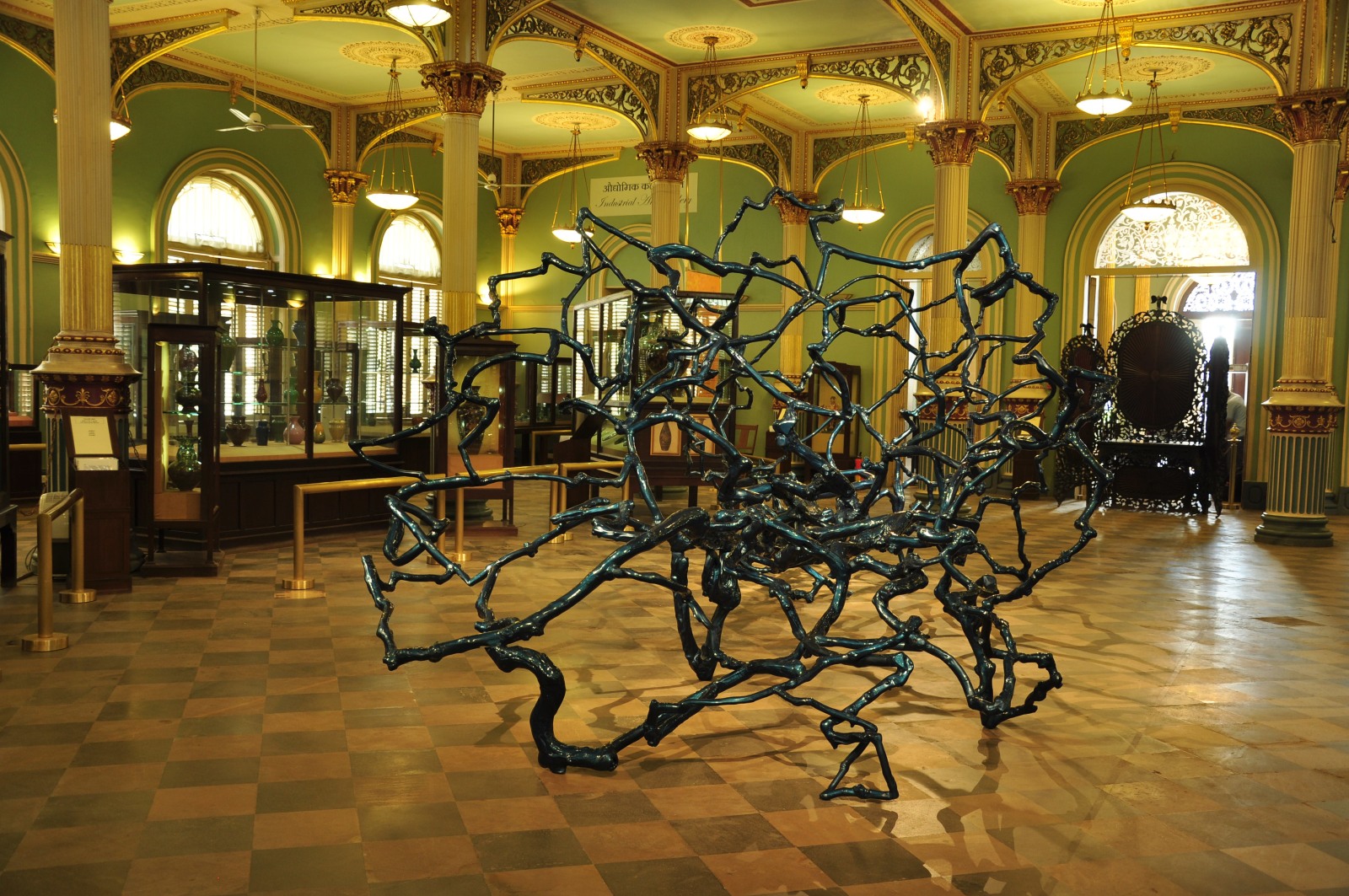
The poet Lord Alfred Tennyson might have characterized nature as “red in tooth and claw”, but Bangalore-based artist Ranjani Shettar would be unlikely to agree. For the next few months, the gilded galleries of the Bhau Daji Lad (BDL) Museum in Mumbai will host the sculptor’s paean to the evanescent glories of the natural world. High Tide for a Blue Moon, an exhibition of installations and two prints, marks Shettar’s first museum solo in India and her debut in Mumbai. Even for those who visited Shettar’s Present Continuous at Talwar Gallery in Delhi from January to December 2011, the BDL show still offers “four new works and sculptures that have never been seen in India before”, Shettar guarantees. They all deal with the subtle aspects of nature—sound, light, and smell.”
In Scent of a Sound (2010-2011), intricately enmeshed steel wire has been dipped in turmeric. As its sculptures hover over our heads, it appears as though the skeletons of oversized flowers are gliding towards us.
Shettar’s buoyant contraptions dangle from ceilings or magically emanate from partitions. In Heliotropes (2005-2011), deep red-brown stems seem to be growing out of a wall, their slight frames reaching out in a silent appeal. Why? “It describes a plant’s gradual movement towards the light over a period of time,” explains Shettar. Heliotrope is taken from Greek: helios means sun and tropos translates as turn. The delicate stems are actually made of vulcanized latex, steel, and cotton thread.
Shettar uses unusual substances such as beeswax, spices, and handmade beads to create swirly, shadowy sculptures. “Ranjani has invented a new language in which materials and form are delightfully pushed beyond their possibilities,” says her gallerist, Deepak Talwar. Shettar says she felt limited by conventional material while studying for her bachelor’s degree in sculpture at the Karnataka Chitrakala Parishath, Bangalore (she graduated in 1998). “That’s when my sculpture had to take off from the floor and I started inventing my own language using rope and PVC tubing,” she says.
With Shettar, the sturdiest of materials often adopt the frailest of forms. Baubles imitate glistening fruit—as in Lagoon (2011), where blue-and-purple beads mimic bunches of giant grapes. Meanwhile, the steel Scent of a Sound could pass for ribbons of golden gossamer. High Tide for a Blue Moon (2012) is a twisted-looking contrivance that hangs within the museum’s atrium. Carved wood from coffee trees glistens like polished enamel—it is coated with blue automobile paint. “I manipulate the material completely by using paint that is not associated with this kind of wood,” Shettar says.
These seemingly bashful sculptures—“They appear and disappear at the same time, and float gently”, as Shettar poetically puts it—a gesture to simple pleasures that city dwellers tend to overlook. In Tunes for a Winter Morning (2012), Shettar has used tamarind kernel paste as a binder and then muslin fabric. “It heightened its mute quality,” she explains. Hence, cream-colored protrusions look as if they are twisting and turning, dissolving into the tangled webcast by their own shadows.
Yet, High Tide is bound together with its ornate surroundings by more than just spools of fishing line. The show is part of the honorary director and curator Tasneem Mehta’s series of exhibitions, called Engaging Traditions, and Shettar was asked to respond to the space because of her interest in craft. “The city museum is full of trapped objects from the last century,” Shettar says. “They are extremely beautiful and well-crafted.” Originally known as the Victoria & Albert Museum, the BDL, according to its website, was established in 1857, to display “the fine and decorative arts” which showcased “the importance of the craftsmanship practiced by various communities of the Bombay Presidency”. These days too, such artifacts, 19-century photographs and bits and pieces of Victoriana, are the BDL’s mainstay. Every once in a while, though, Mehta introduces a contemporary element into its halls. Shettar’s creations “recall the interface of art and science which was one of the founding ideals of the museum”, according to a press release issued by Mehta.
While the exhibition doesn’t contain works made especially for the museum, their amorphous forms certainly intervene into ideas of contemporary craft. “I am enjoying the difference between the craft at the BDL and the way I engage with it now,” says the artist. Her concoctions often involve collaborating with craftsmen who live near Bangalore. “I know how the Kalamkari artists use ink and learn from them,” she says. “High Tide has automobile paint, which represents a very urban craft.” The glistening lacquer beads of Lagoon are the fruits of such joint labor with traditional toymakers. “I have an image of what I want, sometimes I sketch it, sometimes I draw it on the studio floor,” Shettar says. “Then I transfer the drawings onto paper and the welder fabricates it for me. The drawing makes sense only to him and me.”
From certain angles, the artwork High Tide looks like a flat drawing; at others, we get a sense of it as a 3D matrix—like intertwined roots or a network of routes. Nature and nurture are more intimately connected than we think.
-Zehra Jumabhoy